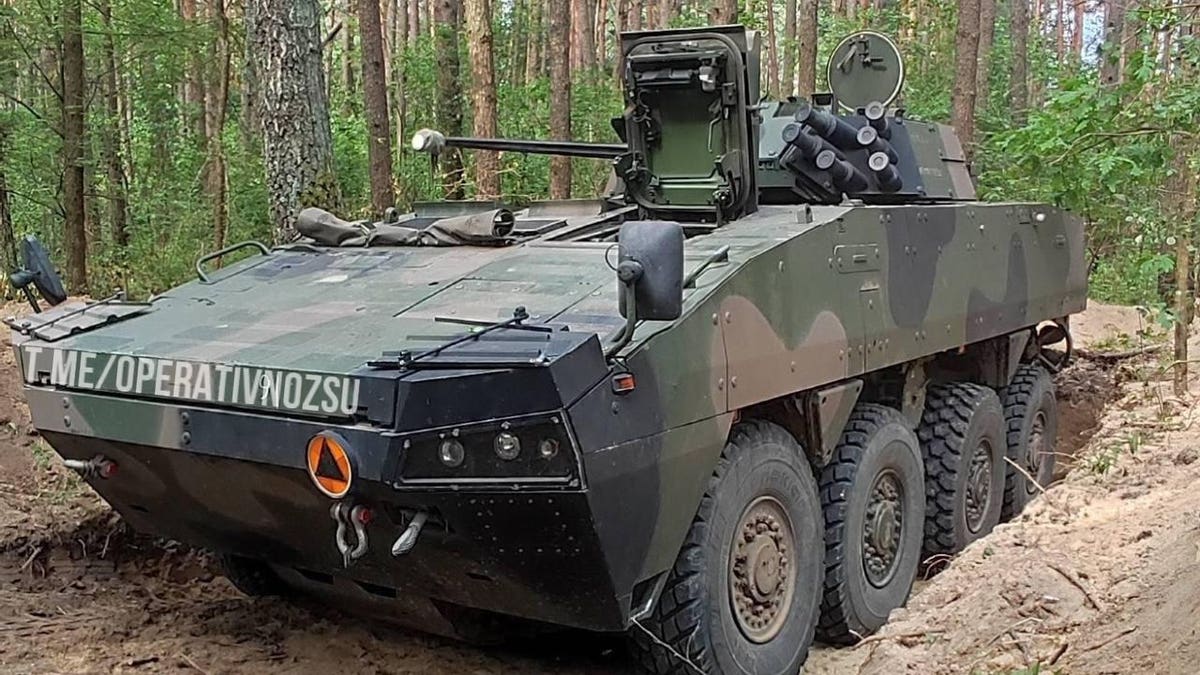One of the Ukrainian army’s newest mechanized brigades appears to be getting some of the Ukrainian army’s newest tanks.
Tanks that are new to Ukraine, that is. The German-designed Leopard 1A5s actually date from the 1980s, but are some of the latest combat vehicles to enter service with Ukrainian forces.
If photos that Ukrainian soldiers posted on social media in recent days are any indication, an early batch of reconditioned Leopard 1A5s will equip the 44th Mechanized Brigade, which formed this spring.
A German-Danish-Dutch consortium pledged to Ukraine at least 135 of the 40-ton, four-person Leopard 1A5s; the first 10 tanks shipped in late July.
It was unclear which units might operate the tanks … until those 44th Brigade soldiers started posting on social media.
It seems the 2,000-person brigade—which already has deployed at least one battalion, equipped with ex-Soviet vehicles, to the front line near Kreminna in northeastern Ukraine—has sent some of its battalions to Poland for training, including instruction on the classic Leopard 1A5.
Swiping through the photos from 44th Brigade troopers, it’s apparent the brigade is getting a powerful but uneven mix of vehicles. The 44th appears to be one of several units adopting Polish-made Wolverine wheeled infantry fighting vehicles.
Warsaw has pledged 200 of the 25-ton IFVs to the Ukrainian war effort. The first examples showed up around Kreminna in recent days, perhaps in service with the 21st Mechanized Brigade, the unit that also operates all of Ukraine’s ex-Swedish combat vehicles.
The Wolverine is a modern and balanced vehicle with space for three crew and eight passengers, an accurate 30-millimeter autocannon and reasonably good armor that should protect the vehicle from heavy machine gun fire.
In the Polish army, the Wolverine operates alongside Leopard 2 and PT-91 tanks. The heavily-armored tanks with their 120-millimeter and 125-millimeter cannons, respectively, lend the combined-arms formation its protection and firepower. The Wolverines give the formation’s infantry vital support and mobility.
The Ukrainian army has configured the 44th Brigade somewhat differently.
It seems all of the roughly 60 Leopard 2s that Ukraine so far has received from its foreign allies belong to the 33rd Mechanized Brigade and the 21st Mechanized Brigade plus possibly one of the army’s four or five tank brigades.
Meanwhile, those 60 PT-91s that Poland pledged so far have equipped just the 22nd Mechanized Brigade. That leaves the 44th Brigade with Leopard 1A5s.
The problem is, the Leopard 1A5 isn’t really in the same class as a Leopard 2 or even a PT-91. While the Leopard 1 boasts an accurate 105-millimeter gun and good day-night optics, it’s thinly protected with armor that’s just a few tens of millimeters thick.
The Leopard 1A5 is about as well-protected as a Wolverine is. A thick application of explosive reactive armor—a favorite of the Ukrainian armed forces—could help to mitigate the Leopard 1A5’s vulnerability, but only somewhat.
As the Ukrainian marine corps learned the hard way in the early days of its long-anticipated 2023 counteroffensive, which kicked off in southern Ukraine on June 4, lightly-armored combat vehicles such as the French-made AMX-10RC really can’t double as tanks. Even when they have the same firepower that tanks do.
Russian mines and artillery shells disabled several of the 37th’s Marine Brigade’s AMXs after inexperienced Ukrainian commanders shoved the wheeled reconnaissance vehicles to the front of their assault on Russian fortifications in Velyka Novosilka in southern Donetsk Oblast. At least one AMX even got disabled by near-misses from mortars that punctured the vehicle’s tires.
The Leopard 1A5 with its steel tracks is less vulnerable to that kind of mobility-kill, but it’s just as likely to suffer damage to its hull and turret—and harm to its crew—as an AMX-10RC is.
Which means the 44th Brigade could ride into battle with a lot of modern IFVs to transport and support its infantry, but without the kinds of tanks that give a mechanized unit the protection it would need for a direct armored assault on enemy fortifications.
No, the 44th will have to find some other role for its Leopard 1A5s—a role that leverages the vehicles’ accurate firepower but doesn’t expose them to intensive enemy fire.
A Leopard 1A5 could function as a mobile gun—an infantry-support vehicle that follows behind the IFVs and fires cannon rounds at the infantry’s request, targeting trenches and bunkers and other strongpoints.
All that is to say, the 44th Brigade is shaping up to be an infantry-heavy formation with an abundance of mobile firepower. Just don’t call it a tank brigade.
What’s most interesting is where the 44th might deploy once the balance of its battalions have completed their training in Poland. The unit already has a battalion on the line west of Kreminna, where it’s fighting a mostly defensive action alongside the 21st Brigade.
It’s on the Kreminna axis that the Russian army chose to launch its countercounteroffensive, a series of attacks the Kremlin clearly hopes will draw Ukranian resources away from Kyiv’s counteroffensive father to the south.
If the 44th does deploy in full near Kreminna, it could be a sign that the Russian countercounteroffensive—having tied up two of Ukraine’s newest Western-equipped brigades—is working.
Read the full article here





